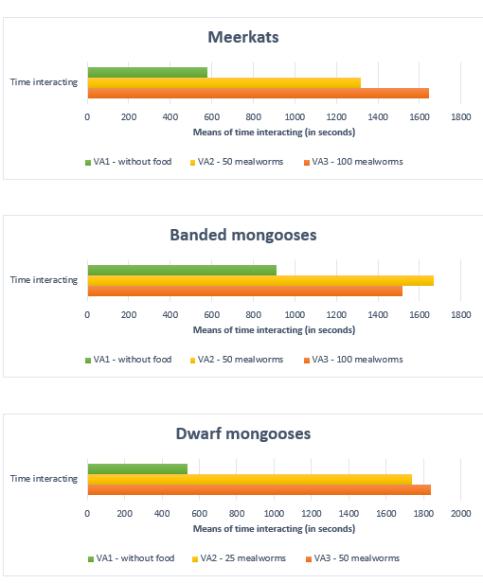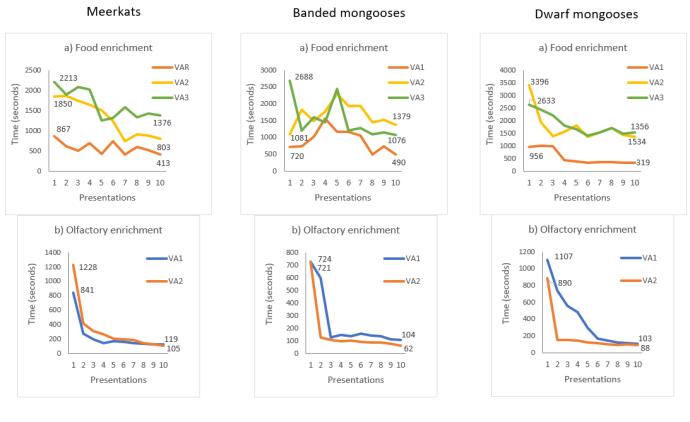1. Differences in the behavioural response to the presence of a food enrichment.
- Meerkats: results showed a 9.4% increase in foraging.
- Banded mongooses: results showed a 10.5% increase in foraging.
- Dwarf mongooses: results showed a 16% increase in foraging
2. Differences in the behavioural response to the three food enrichment variations.
- Meerkats: foraging represented 4.51% of all behaviours when there was no food, 9.6% with 50 worms and 13.4% with 100 worms.
- Banded mongooses: foraging represented 7.3% of all behaviours when there was no food, 14% with 50 worms and 13.6% with 100 worms.
- Dwarf mongooses: foraging represented 6.2% of all behaviours when there was no food, 19.4% with 25 worms and 23.7% with 50 worms.

3. Differences in the behavioural response to the two olfactory enrichment variations.
- Meerkats: the hyena odour (predator) and the elephant odour (non-predator) triggered similar responses in this group of meerkats as the ANOVA test did not show any significant result between behaviours in both scenarios.
- Banded mongooses: the hyena odour (predator) and the elephant odour (non-predator) triggered similar responses in this group.
- Dwarf mongooses: the hyena odour (predator) and the elephant odour (non-predator) triggered similar responses in this group.
4. Differences in time spent interacting with the variations of the food enrichment. (Fig.1)
- Meerkats: they spent more time interacting with the enrichment when there were more mealworms inside the tube.
- Banded mongooses: they spent more time interacting with the enrichment when there were mealworms inside the tube, although doubling the number did not increase variation 3 compared to variation 2.
- Dwarf mongooses: they spent more time interacting with the enrichment when there were more mealworms inside the tube.
5. Differences in time spent interacting with the variations of the olfactory enrichment.
- Meerkats: they did not show any significant difference in time interacting with both odours.
- Banded mongooses: they did not show any significant difference in time interacting with both odours.
- Dwarf mongooses: they did not show any significant difference in time interacting with both odours.
6. Differences in the number of aggressions in the presence of the food enrichment.
- Meerkats: aggressions in this group of meerkats were more common in the presence of mealworms inside the tube.
- Banded mongooses: aggressions in this group of banded mongooses were more common in the presence of mealworms inside the tube.
- Dwarf mongooses: aggressions in this group of dwarf mongooses were more common in the presence of mealworms inside the tube.
7. Habituation to the food and olfactory enrichment. (Fig.2)
- Meerkats: a decrease in time is observed in all three variations (VA1 ‘-52.4%’, VA2 ‘-56.6%’ and VA3 ‘-37.8%’) indicating habituation to the food enrichment. On the other hand, the decline is even greater with the olfactory enrichment in both variations (VA1 ‘-85.9%’ and VA2 ‘-91.5’), suggesting that habituation has a major effect on the olfactory enrichments than on the food enrichments.
- Banded mongooses: a decrease in time is observed in VA1 (‘-31.9%’) and VA3 (‘-60%), however, the time interacting increased with VA2 (‘+27.6%’). On the other hand, the decline is even greater with the olfactory enrichment in both variations (VA1 ‘-85.6%’ and VA2 ‘-91.4’), suggesting that habituation has a major effect on the olfactory enrichments than on the food enrichments.
- Dwarf mongooses: a decrease in time is observed in all three variations (VA1 ‘-66.6%’, VA2 ‘-54.8%’ and VA3 ‘-41.7%’) indicating habituation to the food enrichment. On the other hand, the decline is even greater with the olfactory enrichment in both variations (VA1 ‘-90.7%’ and VA2 ‘-90.1’), suggesting that habituation has a major effect on the olfactory enrichments than on the food enrichments.

Responsible for this page:
Director of undergraduate studies Biology
Last updated:
06/03/20
